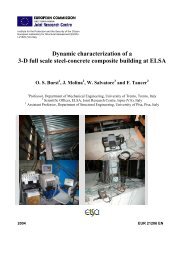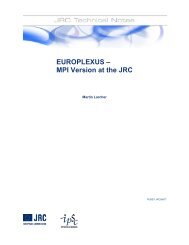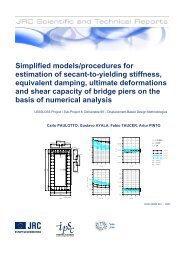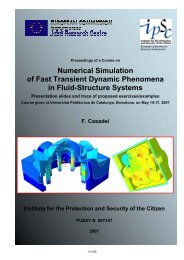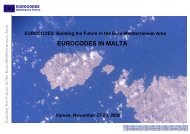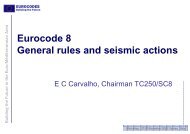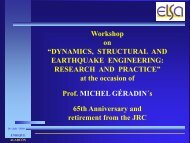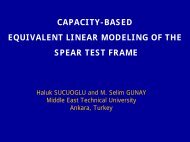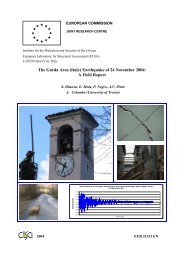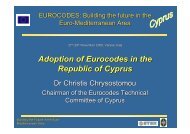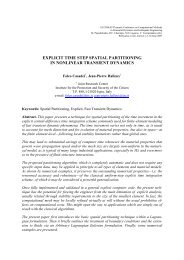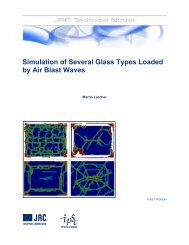Simulation of the Effects of an Air Blast Wave - ELSA - Europa
Simulation of the Effects of an Air Blast Wave - ELSA - Europa
Simulation of the Effects of an Air Blast Wave - ELSA - Europa
- No tags were found...
Create successful ePaper yourself
Turn your PDF publications into a flip-book with our unique Google optimized e-Paper software.
Figure 30: Maximum pressures versus scaled dist<strong>an</strong>ce – cubical models4.5 Spherical Charge with two Symmetry AxesThe weaknesses <strong>of</strong> using a cubical charge c<strong>an</strong> be avoided by using a spherical charge. There are noproblems with a spherical charge from <strong>the</strong> different ending times <strong>of</strong> <strong>the</strong> detonation at <strong>the</strong> corners<strong>an</strong>d with effects resulting from <strong>the</strong> different surfaces.As mentioned initially, <strong>the</strong>se first investigations disregard <strong>the</strong> interaction with <strong>the</strong> structure. So it ispossible to use a spherical volume for <strong>the</strong> surrounding air, too. This allows <strong>an</strong> easier modelling <strong>of</strong><strong>the</strong> mesh, which c<strong>an</strong> be done in several ways. At this point, <strong>the</strong> first approach <strong>of</strong> a sphericallysymmetric regular mesh with <strong>the</strong> centre <strong>of</strong> <strong>the</strong> charge is in CAST3M nei<strong>the</strong>r possible in <strong>an</strong> easyway nor is it necessary in considering <strong>the</strong> behaviour <strong>of</strong> <strong>the</strong> explosive <strong>an</strong>d <strong>the</strong> air.The method used instead converts a cubical model via <strong>the</strong> INCL operator to a spherical model. Theresulting model seems to be relatively regular. The method c<strong>an</strong> be done with <strong>the</strong> following steps:1. Modelling <strong>of</strong> a cubic surface for <strong>the</strong> outer charge (half volume) (Figure 31a, green).2. Modelling <strong>of</strong> a cubic surface for <strong>the</strong> inner charge. This part will be meshed with regular hexahedrons(half volume) (Figure 31a, blue).3. Modelling <strong>of</strong> a cubic surface for <strong>the</strong> air volume around <strong>of</strong> <strong>the</strong> charge (half volume) (Figure 31a,red).4. Projection <strong>of</strong> <strong>the</strong> outer charge surface <strong>an</strong>d <strong>of</strong> <strong>the</strong> air surface with <strong>the</strong> PROJ operator to spheres(Figure 31b).5. Filling <strong>the</strong> volumes between <strong>the</strong> surfaces with hexahedrons (Figure 31c).42



